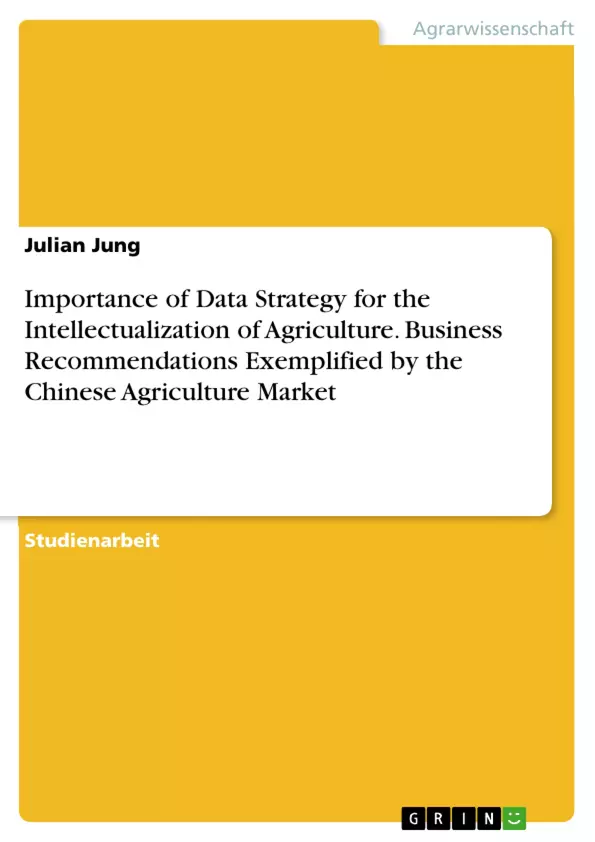The objective of this paper is, firstly, to emphasize the relevance of data and the impact of applying an appropriate corporate data strategy. Secondly, to raise awareness for the intellectualization of productive industries (e.g. agriculture) in order to become more effective. Both objectives are partly covered in the introduction chapter and will be further illuminated in the course of the paper by elaborating on the theoretical background. The aspects Data Strategy and Intelligent Agriculture have received much attention in the past decade. Consequently, they became a central issue in numerous research papers.
Previous work has only focused on one of the subjects at a time and therefore failed to analyze their interplay. Few researchers have addressed both topics simultaneously. This paper seeks to address how both subjects influence and depend on each other. Thirdly, the derivation of concrete guidelines for companies how data strategy and the development of intelligence must be synchronized. Using best practices based on the analysis of the agriculture industry, recommendations will be formulated. The ability to manage data wisely is becoming increasingly important for businesses both today and in the future, and it is therefore a decisive key competence for their success. One central question is to be discussed by this paper: When implementing a data strategy, should an agricultural company develop and continuously adapt the strategy to changing requirements to remain competitive in fast-moving markets?
To answer this question, we look at a company that has successfully made the transition from a traditional agricultural business to a cloud service provider: Top Cloud-Agri Technology Co., Ltd. (TPYN). This methodology ensures proximity to practical application, which in turn facilitates the development of practice-oriented use cases. Later, business recommendations (Chapter 3) will be derived from the company's strategic decisions based on the theoretically knowledge about data strategy gained in Chapter 2. Based on the subject, the paper can be assigned to the discipline of strategic IT management (SITM). Furthermore, a reference to the cross-disciplinary field of digital transformation can be made. Eventually, emerging technologies are required to enable and support the growing intelligence.
Inhaltsverzeichnis
- 1 Introduction
- 1.1 Problem Statement
- 1.2 Objectives
- 1.3 Structure of the Paper
- 2 Data Strategy and Intelligent Agriculture
- 2.1 Data Strategy
- 2.1.1 Defensive Data Strategy
- 2.1.2 Offensive Data Strategy
- 2.2 Intelligent Agriculture - Agriculture 4.0
- 3 Analysis of Opportunities and Requirements
- 4 Lessons Learned
- 5 Summary and Conclusion
Zielsetzung und Themenschwerpunkte
Diese Arbeit befasst sich mit der Bedeutung einer Data Strategy für die Digitalisierung der Landwirtschaft. Sie analysiert, wie Datenstrategien zur Entwicklung intelligenter und effizienterer landwirtschaftlicher Praktiken beitragen können, insbesondere im Kontext des chinesischen Landwirtschaftsmarktes.
- Die Herausforderungen und Chancen der Digitalisierung in der Landwirtschaft
- Die Rolle von Datenstrategien im Kontext intelligenter Landwirtschaft ("Agriculture 4.0")
- Analyse der Möglichkeiten und Anforderungen für die Entwicklung einer erfolgreichen Data Strategy
- Die Bedeutung von Daten für die Steigerung der Effizienz und Nachhaltigkeit in der Landwirtschaft
- Beispiele aus dem chinesischen Landwirtschaftsmarkt
Zusammenfassung der Kapitel
- Kapitel 1: Introduction Dieses Kapitel führt das Thema ein und stellt die Problematik sowie die Ziele der Arbeit dar. Es beschreibt die Bedeutung der Datenmanagementfähigkeit im Kontext des digitalen Wandels und erläutert die wachsende Datenmenge in der modernen Welt.
- Kapitel 2: Data Strategy and Intelligent Agriculture Dieses Kapitel definiert den Begriff der Data Strategy und stellt zwei unterschiedliche Strategien – defensive und offensive – vor. Es beleuchtet den Zusammenhang zwischen Data Strategy und intelligenter Landwirtschaft ("Agriculture 4.0") und erklärt, wie Daten zur Entwicklung innovativer landwirtschaftlicher Methoden beitragen können.
- Kapitel 3: Analysis of Opportunities and Requirements Dieses Kapitel befasst sich mit den Chancen und Herausforderungen der Digitalisierung in der Landwirtschaft. Es analysiert die Möglichkeiten, die Datenstrategien bieten, um die Effizienz und Nachhaltigkeit der Landwirtschaft zu steigern. Zudem werden die notwendigen Voraussetzungen für die erfolgreiche Implementierung einer Data Strategy in der Landwirtschaft beleuchtet.
- Kapitel 4: Lessons Learned Dieses Kapitel fasst die wichtigsten Erkenntnisse aus der Analyse der Data Strategy im Kontext intelligenter Landwirtschaft zusammen. Es beleuchtet bewährte Praktiken und wichtige Erfolgsfaktoren für die Entwicklung einer effektiven Data Strategy.
Schlüsselwörter
Data Strategy, Intelligente Landwirtschaft, Agriculture 4.0, Digitalisierung der Landwirtschaft, Big Data, Internet of Things (IoT), China, Chinesischer Landwirtschaftsmarkt, Datenanalyse, Effizienzsteigerung, Nachhaltigkeit, Erfolgsfaktoren.
- Quote paper
- Julian Jung (Author), 2021, Importance of Data Strategy for the Intellectualization of Agriculture. Business Recommendations Exemplified by the Chinese Agriculture Market, Munich, GRIN Verlag, https://www.grin.com/document/1003663



